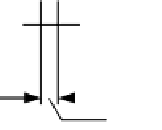Information Technology Reference
In-Depth Information
2
Quantization Index Modulation and Watermark Embedding
Using quantization index modulation (QIM) to embed watermark into still images can
achieve a good tradeoff among embedding rate, distortion, and robustness [1-3]. The
method is briefly outlined in this section.
Let
s
(
x
;
m
) be an ensemble of embedding function where
x
is the host signal and
m
is an index. Each function must be sufficiently close to
x
to ensure imperceptibility.
Fig. 1 illustrates a QIM scheme with
m
{0,1} representing binary values of the data
to be embedded. In this case, two quantizers are used, and the corresponding sets of
reconstruction points shown as solid dots and circles respectively.
[
∈
]
s
(
x
;
m
)
=
Q
x
+
d
(
m
)
−
d
(
m
),
m
=
0
1
,
(1)
where
Q
is a rounding operator, and
d
(
m
) corresponds to the
m
-th quantizer.
In the detector, by finding which of the two quantizers having a quantized value
closest to the received data bit, the embedded data can easily be retrieved. Embedding
capacity, induced distortion and robustness are associated, respectively, with the
number of quantizers, the size and shape of quantization cells, and the minimum dis-
tance δ
min
between the reconstruction points of different quantizers.
x
s
(
x
;0)
s
(
x
;1)
δ
min
Fig. 1.
QIM: solid dots and circles are reconstruction points of two quantizers respectively
It is clear that a large δ
min
, therefore better robustness, requires large quantization
cells hence poor invisibility. By embedding more than one bit into each host data
point, embedding capacity may be increased. In this case, however, δ
min
will be re-
duced leading to less robustness.
A simple implementation of QIM using block DCT may be obtained like this: The
host image is first segmented into 8×8 blocks. Two-dimensional DCT is performed on
each block. Selected coefficients are then taken from each transform-domain block
and quantization-index-modulated. These QIM modified coefficients are used to re-
place the original ones in the inverse block DCT to produce a marked image.
More sophisticated implementations can be found in the literature. For example, in
[5], the chosen DCT coefficients are pseudo-randomly scrambled in order to remove
















